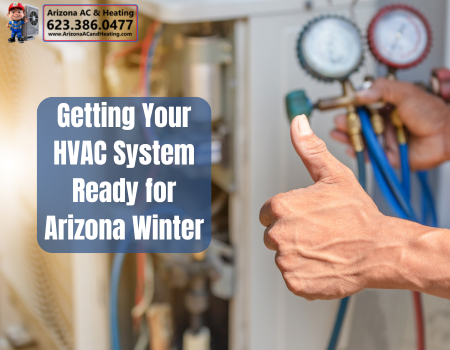Although Arizona is renowned for its scorching summer temperatures, the state’s winters can be surprisingly chilly, especially in the evenings and higher elevations. While daytime temperatures in cities like Phoenix and Tucson may remain mild, nighttime can bring a significant drop, making it essential to prepare your HVAC system for the season ahead.
- Schedule a Professional Inspection
 Before the cooler weather settles in, it’s a good idea to schedule a professional inspection and maintenance check for your HVAC system. A certified technician will examine the system to ensure it’s running efficiently and safely. This inspection typically includes:
Before the cooler weather settles in, it’s a good idea to schedule a professional inspection and maintenance check for your HVAC system. A certified technician will examine the system to ensure it’s running efficiently and safely. This inspection typically includes:
– Checking the heat exchanger: The heat exchanger is critical for transferring heat from the combustion chamber into the air circulated through your home. It should be clean and free from cracks to prevent potential carbon monoxide leaks.
– Examining the furnace: Technicians will inspect the furnace for any issues such as faulty components, clogged air filters, or gas line problems.
– Lubricating moving parts: Many HVAC systems have motors and other moving parts that need lubrication to prevent wear and tear.
– Cleaning the coils: Dirty coils can lead to inefficient operation, so cleaning is crucial for energy efficiency and proper heating.
Having a professional inspect and service your system can help detect small issues before they become bigger problems.
- Replace Air Filters
One of the most common maintenance tasks you can perform on your own is changing the air filter. Over time, air filters can become clogged with dust, dirt, and debris, which can reduce airflow and efficiency. A dirty filter also forces the system to work harder, which can lead to higher energy costs and premature wear on the HVAC system.
- Clean and Inspect Vents and Ducts
Ductwork and vents can accumulate dust, dirt, and debris over time, reducing the efficiency of your HVAC system. This can also affect the quality of air indoor. Before the winter season, inspect the vents and air ducts for any blockages or obstructions. Use a vacuum to clean the vents and ensure they are unobstructed so that warm air can flow freely.
- Check the Thermostat
The thermostat is the control center of your HVAC system. If you haven’t already, test your thermostat to ensure it is working properly. Set the thermostat to heating mode and check that it is responding to your desired temperature. Many homeowners upgrade to programmable or smart thermostats, which can be particularly useful during the winter months.
A programmable thermostat can automatically adjust the temperature in your home based on your schedule, preventing unnecessary heating when you’re away and ensuring comfort when you’re home. Smart thermostats even allow you to control the temperature remotely using a smartphone app, which is perfect for making adjustments while you’re on the go.
- Ensure Proper Insulation
Proper insulation is essential for maintaining the desired temperature inside your home and reducing energy bills. Check areas such as attics, basements, and crawl spaces for any gaps or areas that need additional insulation. Properly insulating your home helps keep heat in and cold out, making it easier for your HVAC system to maintain warmth during the winter months.
- Test the Heating System
Before the first cold snap arrives, test your heating system to ensure it is working correctly. Turn the thermostat to heating mode and set the temperature higher than the current indoor temperature. The system should turn on, and you should begin to feel warm air circulating through the vents.
If your heating system doesn’t respond or the air feels cool instead of warm, it could indicate an issue with the furnace or heat pump. Common problems include dirty burners, faulty or broken thermostats, or ignition issues. In these cases, contact a professional technician like Arizona AC and Heating to address the issue promptly.
- Check Carbon Monoxide Detectors
If you rely on a gas-powered furnace or heating system, carbon monoxide detection is essential for your safety. Carbon monoxide is a colorless, odorless gas that can be produced by malfunctioning heating systems, and it can be deadly if inhaled. Be sure to check that your carbon monoxide detectors are functioning properly and that the batteries are fresh. Test the detectors to ensure they’ll alert you if dangerous levels of carbon monoxide are detected in your home.
- Consider a Humidifier
Arizona’s dry climate can make winter air feel even colder, and indoor heating can further lower humidity levels. Dry air can cause skin irritation, respiratory discomfort, and static electricity buildup. To counteract the dryness, consider using a whole-house humidifier, which can be integrated with your HVAC system.
- Prepare for Energy Efficiency
Energy efficiency is always a concern, especially as utility bills can rise during the colder months. To improve energy efficiency, ensure that your HVAC system is well-maintained, clean, and properly sealed. You can also implement additional energy-saving measures, such as using ceiling fans to circulate warm air, closing curtains at night to retain heat, and adjusting your thermostat to lower temperatures when you’re not at home.
As Arizona’s winters can be unpredictable, it’s essential to prepare your HVAC system to ensure comfort and efficiency throughout the colder months. By scheduling a professional inspection, replacing air filters, inspecting ducts, checking your thermostat, and making small adjustments like adding insulation, you can ensure that your heating system operates smoothly. Taking these steps will not only help you stay warm but also save on energy costs and extend the life of your HVAC system.

